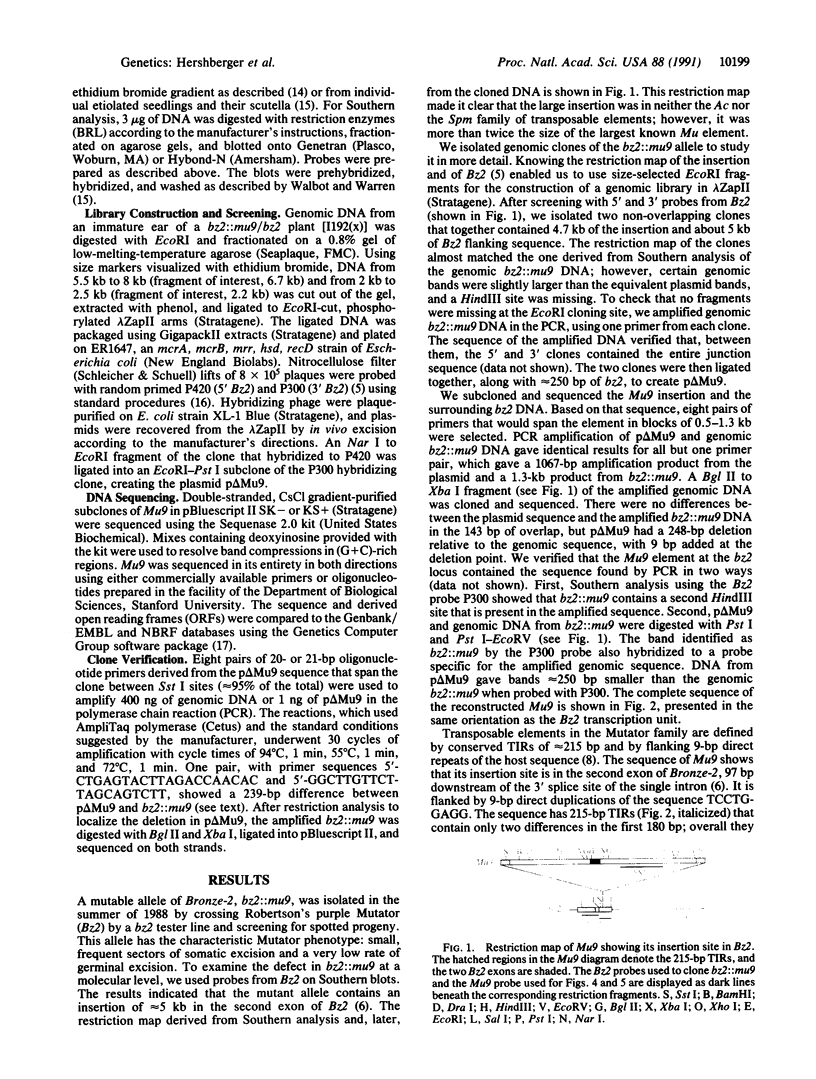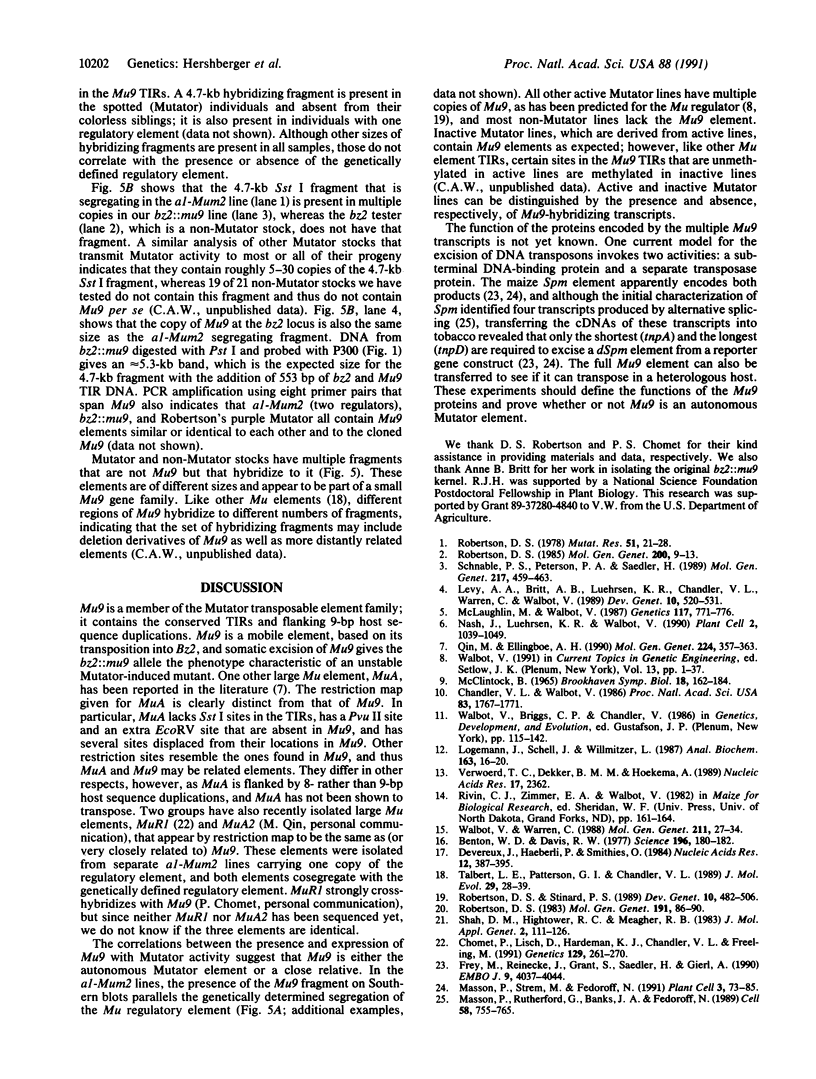Abstract
Mutator is a powerful system for generating new mutants in maize. Mutator activity is attributable to a family of transposable, multicopy Mu elements, but none of the known elements is an autonomous (regulatory) element. This paper reports the discovery of Mu9, a 4942-base-pair Mu element that was cloned after it transposed into the Bronze-2 locus. Like other Mu elements, Mu9 has approximately 215-base-pair terminal inverted repeats and creates a 9-base-pair host sequence duplication upon insertion. A small gene family of elements that cross-hybridize to Mu9 has been found in all maize lines, and one of the other known Mu elements, Mu5, probably arose as a deletion of Mu9. Mu9 has several of the properties expected for the proposed regulator of Mutator activity. (i) The presence of Mu9 parallels the presence of Mutator activity in individuals from a line that genetically segregates for the Mu regulator. (ii) Lines that transmit Mutator to greater than 90% of their progeny have multiple copies of Mu9. (iii) Most maize lines that lack Mutator activity and that are not descended from Mutator lines lack the Mu9 element. (iv) Transcripts that hybridize to Mu9 are abundant in active Mutator lines, but they are absent from lines that have epigenetically lost Mutator activity. These correlations suggest that Mu9 is a candidate for the autonomous Mutator element.
Full text
PDF




Images in this article
Selected References
These references are in PubMed. This may not be the complete list of references from this article.
- Benton W. D., Davis R. W. Screening lambdagt recombinant clones by hybridization to single plaques in situ. Science. 1977 Apr 8;196(4286):180–182. doi: 10.1126/science.322279. [DOI] [PubMed] [Google Scholar]
- Chandler V. L., Walbot V. DNA modification of a maize transposable element correlates with loss of activity. Proc Natl Acad Sci U S A. 1986 Mar;83(6):1767–1771. doi: 10.1073/pnas.83.6.1767. [DOI] [PMC free article] [PubMed] [Google Scholar]
- Chomet P., Lisch D., Hardeman K. J., Chandler V. L., Freeling M. Identification of a regulatory transposon that controls the Mutator transposable element system in maize. Genetics. 1991 Sep;129(1):261–270. doi: 10.1093/genetics/129.1.261. [DOI] [PMC free article] [PubMed] [Google Scholar]
- Devereux J., Haeberli P., Smithies O. A comprehensive set of sequence analysis programs for the VAX. Nucleic Acids Res. 1984 Jan 11;12(1 Pt 1):387–395. doi: 10.1093/nar/12.1part1.387. [DOI] [PMC free article] [PubMed] [Google Scholar]
- Frey M., Reinecke J., Grant S., Saedler H., Gierl A. Excision of the En/Spm transposable element of Zea mays requires two element-encoded proteins. EMBO J. 1990 Dec;9(12):4037–4044. doi: 10.1002/j.1460-2075.1990.tb07625.x. [DOI] [PMC free article] [PubMed] [Google Scholar]
- Levy A. A., Britt A. B., Luehrsen K. R., Chandler V. L., Warren C., Walbot V. Developmental and genetic aspects of Mutator excision in maize. Dev Genet. 1989;10(6):520–531. doi: 10.1002/dvg.1020100611. [DOI] [PubMed] [Google Scholar]
- Logemann J., Schell J., Willmitzer L. Improved method for the isolation of RNA from plant tissues. Anal Biochem. 1987 May 15;163(1):16–20. doi: 10.1016/0003-2697(87)90086-8. [DOI] [PubMed] [Google Scholar]
- Masson P., Rutherford G., Banks J. A., Fedoroff N. Essential large transcripts of the maize Spm transposable element are generated by alternative splicing. Cell. 1989 Aug 25;58(4):755–765. doi: 10.1016/0092-8674(89)90109-8. [DOI] [PubMed] [Google Scholar]
- Masson P., Strem M., Fedoroff N. The tnpA and tnpD gene products of the Spm element are required for transposition in tobacco. Plant Cell. 1991 Jan;3(1):73–85. doi: 10.1105/tpc.3.1.73. [DOI] [PMC free article] [PubMed] [Google Scholar]
- McLaughlin M., Walbot V. Cloning of a mutable bz2 allele of maize by transposon tagging and differential hybridization. Genetics. 1987 Dec;117(4):771–776. doi: 10.1093/genetics/117.4.771. [DOI] [PMC free article] [PubMed] [Google Scholar]
- Nash J., Luehrsen K. R., Walbot V. Bronze-2 gene of maize: reconstruction of a wild-type allele and analysis of transcription and splicing. Plant Cell. 1990 Nov;2(11):1039–1049. doi: 10.1105/tpc.2.11.1039. [DOI] [PMC free article] [PubMed] [Google Scholar]
- Qin M. M., Ellingboe A. H. A transcript identified by MuA of maize is associated with Mutator activity. Mol Gen Genet. 1990 Dec;224(3):357–363. doi: 10.1007/BF00262429. [DOI] [PubMed] [Google Scholar]
- Schnable P. S., Peterson P. A., Saedler H. The bz-rcy allele of the Cy transposable element system of Zea mays contains a Mu-like element insertion. Mol Gen Genet. 1989 Jun;217(2-3):459–463. doi: 10.1007/BF02464917. [DOI] [PubMed] [Google Scholar]
- Shah D. M., Hightower R. C., Meagher R. B. Genes encoding actin in higher plants: intron positions are highly conserved but the coding sequences are not. J Mol Appl Genet. 1983;2(1):111–126. [PubMed] [Google Scholar]
- Talbert L. E., Patterson G. I., Chandler V. L. Mu transposable elements are structurally diverse and distributed throughout the genus Zea. J Mol Evol. 1989 Jul;29(1):28–39. doi: 10.1007/BF02106179. [DOI] [PubMed] [Google Scholar]
- Verwoerd T. C., Dekker B. M., Hoekema A. A small-scale procedure for the rapid isolation of plant RNAs. Nucleic Acids Res. 1989 Mar 25;17(6):2362–2362. doi: 10.1093/nar/17.6.2362. [DOI] [PMC free article] [PubMed] [Google Scholar]
- Walbot V. The Mutator transposable element family of maize. Genet Eng (N Y) 1991;13:1–37. doi: 10.1007/978-1-4615-3760-1_1. [DOI] [PubMed] [Google Scholar]
- Walbot V., Warren C. Regulation of Mu element copy number in maize lines with an active or inactive Mutator transposable element system. Mol Gen Genet. 1988 Jan;211(1):27–34. doi: 10.1007/BF00338389. [DOI] [PubMed] [Google Scholar]






